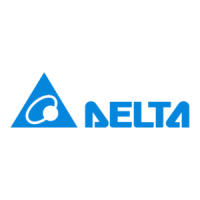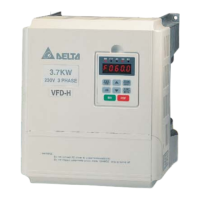Do you have a question about the Delta VFD300C43S-HS and is the answer not in the manual?
Lists contact information for Delta Electronics in various Asian locations, including Shanghai, Japan, and Korea.
Lists contact information for Delta Electronics in EMEA region countries like Netherlands, Germany, France, Spain, Italy, Russia, Turkey, and GCC.
Lists contact information for Delta Electronics in the Americas, including Raleigh (USA), Sao Paulo (Brazil), and Mexico.
Provides details about information found on the product's nameplate, including model name, voltage, current, frequency range, and certifications.
Explains the structure and meaning of the model name for the C2000 series drives, detailing installation type and applicable motor capacity.
Details the format and components of the serial number, indicating production number, week, year, and factory.
Describes how to use a mobile device and QR code to access Delta's after-service website for repair applications.
Explains the function of the RFI jumper and its role in protecting the drive against surges and noise, including precautions for removal.
Provides physical dimensions and mounting hole specifications for various drive frames (D0, D, E, F, G, H), crucial for installation planning.
Explains the necessary clearance for mounting the AC motor drive to ensure proper heat dissipation and prevent fire accidents.
Provides data on air flow rates for cooling and power dissipation for various models, crucial for ventilation system design.
Provides step-by-step instructions for unpacking the AC motor drive, including cutting straps, removing covers, and loosening screws for different frames.
Details the location of lifting holes for frames D0 to H and the correct method for lifting the drive safely.
Illustrates the system wiring diagram for AC input and output terminals, including essential components like NFB, contactors, and reactors.
Provides wiring diagrams for main circuit connections for Frame D0-F and Frame G-H, detailing connections for power, motors, and optional components.
Presents main circuit wiring diagrams for various drive frames (D0-F, G-H), showing connections for power input, output, and brake units.
Details specifications for main circuit terminal wiring, including ring lug types, wire gauges, and screw torque requirements.
Provides instructions for removing the drive's top cover to access multi-function input and output terminals for wiring, specific to different frames.
Details specifications for control terminals, including terminal functions, conductor types, wire gauges, and torque requirements.
Explains how to remove the control board terminal block.
Lists brake resistors and units for 460V motors, including specifications like braking torque, resistor value, and current.
Recommends non-fuse circuit breaker ratings for different C2000-HS models, complying with UL standards.
Provides fuse specifications and part numbers for 460V models, including compliance with NEC and Canadian Electrical Code.
Explains the function and specifications of AC input reactors for improving power factor and reducing surges.
Details external EMC filters for C2000 series, including model names, carrier frequency, emission levels, and installation precautions.
Describes panel cutout dimensions for wall and embedded mounting of digital keypads, including IP66 waterproof level.
Lists components of conduit box kits for various drive frames (D0, D, E, F, G, H) with model numbers and quantities.
Shows fan models for heat sinks and capacitors applicable to different drive frames (D0, D, E, F, G, H).
Provides cutout dimensions and mounting hole specifications for flange mounting kits for frames D0–F.
Details components and installation of the MKC-PTCG power terminal kit.
Explains the specifications and features of the IFD6530 USB/RS-485 communication interface.
Outlines the general procedure for installing option cards, including cover removal and screw handling for different frames.
Describes the EMC-D42A extension card for digital I/O, detailing terminals, functions, and sink/source modes.
Explains the EMC-D611A extension card for 6-point digital inputs with 110VAC voltage, detailing terminals and functions.
Details the EMC-R6AA extension card for 6-point normally open relay outputs, explaining terminals and functions.
Describes the EMC-A22A extension card for analog I/O, detailing terminals and functions for voltage/current modes.
Explains the EMC-BPS01 +24V power card, including terminals, input power, and functions, noting unsupported features.
Details the EMC-PG01L/PG02L PG card for line driver signals, explaining terminals and functions.
Explains the EMC-PG01O/PG02O PG card for open collector signals, detailing terminals and functions.
Describes the EMC-PG01U/PG02U PG card for ABZ encoder and UVW Hall signals, detailing terminals and functions.
Details the EMC-PG01R PG card for resolver signals, explaining terminal descriptions and wiring diagrams.
Explains the CMC-MOD01 communication card for Modbus TCP, covering features, specifications, and communication parameters.
Details the CMC-PD01 communication card for PROFIBUS DP, including features, specifications, and LED indicators.
Explains the CMC-DN01 communication card for DeviceNet, covering functions, profile, specifications, and LED indicators.
Details the CMC-EIP01 communication card for EtherNet/IP, including features, specifications, and communication parameters.
Explains the CMC-EC01 communication card for EtherCAT, including features, profile, specifications, and network connection.
Details the CMC-PN01 communication card for PROFINET, including features, profile, specifications, and RJ45 PIN definitions.
Explains the EMC-COP01 communication card for CANopen, including terminating resistor position, RJ45 pin definition, and specifications.
Lists Delta's standard fieldbus cables for CANopen, DeviceNet, Ethernet/EtherCAT, and PROFIBUS, including part numbers and lengths.
Provides a specification table for the 460V series drives, detailing output rating, input rating, and drive weight.
Details environmental requirements for operation, storage, and transportation, including installation location, temperature, humidity, and pollution levels.
Outlines operation temperature and protection levels for the drive, specifying conditions for different frames and conduit box usage.
Presents derating curves related to ambient temperature and altitude, including UL Type I/IP20 and UL Open Type specifications.
Describes the digital keypad's communication protocol, installation method, and functions of individual keys.
Explains the functions of the KPC-CC01 digital keypad, covering power-on display, menu navigation, and various operational modes.
Provides instructions for installing TPEditor software and basic functions for creating and editing HMI pages.
Lists fault codes displayed on the LCM keypad, providing descriptions and corrective actions for keypad-related errors.
Lists functions not supported by TPEditor on the KPC-CC01 keypad, such as Local Page Setting and Read from TP.
Summarizes drive parameters including identity code, rated current, parameter reset, start-up display, and multi-function display content.
Details basic parameters such as maximum operation frequency, output frequency/voltage for motors 1 and 2, and acceleration/deceleration times.
Describes digital input/output parameters, covering two-wire/three-wire operation control, multi-function input commands, and multi-function output settings.
Explains analog input/output parameters, including selection for AVI, ACI, AUI, bias modes, and filter times.
Lists multi-step speed parameters, including frequency settings for each step and position commands.
Details motor parameters such as auto-tuning, full-load current, rated power, rated speed, number of poles, and no-load current.
Outlines protection parameters including low voltage level, over-voltage stall prevention, over-current stall prevention, and electronic thermal relay settings.
Summarizes special parameters such as software brake level, DC brake time, voltage increasing gain, and restart after momentary power loss.
Details high-function PID parameters, including feedback selection, gains, and output command limits.
Covers system control settings like auto-tuning for ASR/APR, inertia estimate, zero servo, linear-cross, and frequency saving.
Explains how to get system inertia from Pr.11-01, including calculations for induction and permanent magnet motors.
Sets the switching point for ASR in the FOC area, affecting response and noise.
Sets the low-speed bandwidth for ASR1, adjustable for response and vibration.
Sets the high-speed bandwidth for ASR2, adjustable for response and vibration.
Sets the zero-speed bandwidth, adjustable for improving starting performance and reducing steady-state error.
Allows selection of application macros like Compressor (IM), Fan, Pump, or AHU for automatic default value adjustment.
Explains selecting the input terminal for AI10, covering functions like frequency command, torque command, PID target, and thermistor input.
Details selecting the input terminal for AI11, covering functions like frequency command, torque command, PID target, and PID feedback signal.
Explains setting the analog input filter time for AI10 to filter noisy signals and improve control stability.
Details the analog input filter time for AI11, used to filter noisy signals and adjust control response.
Specifies treatment for 4–20mA signal loss on AI10, including options to continue operation, ramp to stop, or stop immediately.
Explains treatment for 4–20mA signal loss on AI11, covering options to continue operation, ramp to stop, or stop immediately.
Details selection for the AO10 output terminal, covering output frequency, frequency command, motor speed, output current, and voltage.
Explains selection for the AO11 output terminal, covering output frequency, frequency command, motor speed, output current, and voltage.
Describes adjusting voltage level output to the analog meter from the analog signal (Pr.14-12) of the drive's output terminal AFM1.
Explains adjusting voltage level output to the analog meter from the analog signal (Pr.14-13) of the drive's output terminal AFM2.
Determines voltage reverse output for AO10 based on settings Pr.14-36=2 or Pr.14-37=2.
Determines voltage reverse output for AO11 based on settings Pr.14-36=2 or Pr.14-37=2.
Explains selecting the input terminal for AI10, covering 0–10V (AVI10), 0–20mA (ACI10), and 4–20mA (ACI10).
Details selecting the input terminal for AI11, covering 0–10V (AVI11), 0–20mA (ACI11), and 4–20mA (ACI11).
Sets the DC output level for AO10.
Sets the DC output level for AO11.
Sets the filter output time for AO10.
Sets the filter output time for AO11.
Provides an overview of the CANopen protocol, its standardization, specifications, and RJ45 pin definition.
Details CANopen wiring using an external adapter card EMC-COP01 and RJ45 cable, including termination resistor requirements.
Describes CANopen control modes, including DS402 standard and Delta standard, covering speed, torque, position, and home control.
Lists CANopen supporting functions and services, including index and sub-index definitions for C2000-HS control index and Delta standard modes.
Provides a table of CANopen fault codes with their displays, descriptions, fault registers, and fault codes.
Explains the function of CANopen RUN and ERR LEDs, detailing their status, condition, and corresponding CANopen states.
Provides a summary of PLC functions, including the ladder diagram editing tool WPLSoft and its system requirements.
Lists important notes and precautions before using PLC functions, covering communication settings, node identification, and program download/upload procedures.
Explains how to connect to PC and implement PLC functions, including connection steps and wiring diagrams.
Introduces fundamental principles of PLC ladder diagrams, including schematic diagrams, symbol explanations, and common control circuits.
Details various PLC device functions, covering specifications for algorithmic control, I/O terminals, relay bit forms, timers, counters, and data registers.
Explains the command window interface, including an overview of basic commands, output commands, timer/counter commands, and main control commands.
Lists common PLC error codes, their descriptions, action levels, reset methods, and corrective actions for troubleshooting.
Describes controlling the drive using CANopen as a master, covering activation, memory settings, and communication parameters.
Explains various PLC mode controls for speed, torque, homing, and position, providing register tables for each.
Details internal communications using RS-485 protocol, covering master-slave structure, master settings, and hardware wiring.
Explains using MI8 for high-speed counting and frequency calculation, including related parameters.
Describes using the MODRW command for C2000-HS internal PLC to control slave devices via RS-485, including examples and practical applications.
Explains internal PLC calendar functions, including supported commands, time display, and related special M items.
Presents failure rate data for drive safety functions based on standards like IEC61508 and ISO13849.
Describes the Safe Torque Off (STO) terminal function, detailing its hardware control and operation principles.
Illustrates wiring diagrams for internal STO circuits and control loops, showing connections for I/O cards and ESTOP switches.
Details parameters related to STO function, including alarm latch, multi-function output settings, and display content.
Explains operating sequences for normal operation, STO, and related fault conditions based on parameter settings.
Lists new error codes for STO function, including fault codes, descriptions, and corrective actions for different firmware versions.












